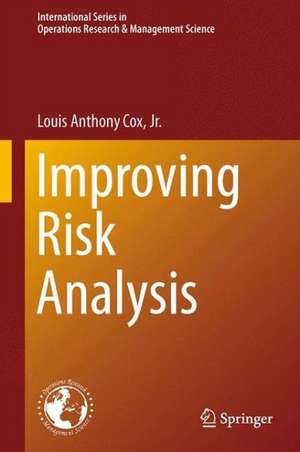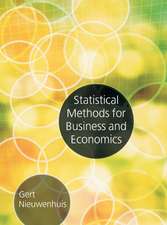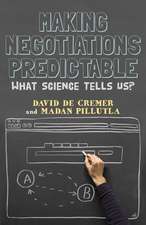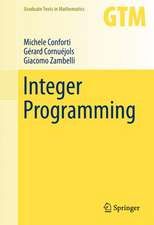Improving Risk Analysis: International Series in Operations Research & Management Science, cartea 185
Autor Louis Anthony Cox Jr.en Limba Engleză Hardback – 2 feb 2013
The book is divided into three parts. Parts 1 shows how high-quality risk analysis can improve the clarity and effectiveness of individual, community, and enterprise decisions when the consequences of different choices are uncertain. Part 2 discusses social decisions. Part 3 illustrates these methods and models, showing how to apply them to health effects of particulate air pollution.
"Tony Cox’s new book addresses what risk analysts and policy makers most need to know: How to find out what causes what, and how to quantify the practical differences that changes in risk management practices would make. The constructive methods in Improving Risk Analysis will be invaluable in helping practitioners to deliver more useful insights to inform high-stakes decisions and policy,in areas ranging from disaster planning to counter-terrorism investments to enterprise risk management to air pollution abatement policies. Better risk management is possible and practicable; Improving Risk Analysis explains how."
Elisabeth Pate-Cornell, Stanford University
"Improving Risk Analysis offers crucial advice for moving policy-relevant risk analyses towards more defensible, causally-based methods. Tony Cox draws on his extensive experience to offer sound advice and insights that will be invaluable to both policy makers and analysts in strengthening the foundations for important risk analyses. This much-needed book should be required reading for policy makers and policy analysts confronting uncertain risks and seeking more trustworthy risk analyses."
Seth Guikema, Johns Hopkins University
"TonyCox has been a trail blazer in quantitative risk analysis, and his new book gives readers the knowledge and tools needed to cut through the complexity and advocacy inherent in risk analysis. Cox’s careful exposition is detailed and thorough, yet accessible to non-technical readers interested in understanding uncertain risks and the outcomes associated with different mitigation actions. Improving Risk Analysis should be required reading for public officials responsible for making policy decisions about how best to protect public health and safety in an uncertain world."
Susan E. Dudley, George Washington University
| Toate formatele și edițiile | Preț | Express |
|---|---|---|
| Paperback (1) | 950.21 lei 6-8 săpt. | |
| Springer – 8 feb 2015 | 950.21 lei 6-8 săpt. | |
| Hardback (1) | 954.93 lei 6-8 săpt. | |
| Springer – 2 feb 2013 | 954.93 lei 6-8 săpt. |
Din seria International Series in Operations Research & Management Science
- 20%
 Preț: 331.25 lei
Preț: 331.25 lei - 20%
 Preț: 570.61 lei
Preț: 570.61 lei - 18%
 Preț: 1132.02 lei
Preț: 1132.02 lei - 18%
 Preț: 773.72 lei
Preț: 773.72 lei -
 Preț: 170.39 lei
Preț: 170.39 lei - 17%
 Preț: 459.34 lei
Preț: 459.34 lei - 17%
 Preț: 360.47 lei
Preț: 360.47 lei -
 Preț: 263.40 lei
Preț: 263.40 lei - 24%
 Preț: 905.30 lei
Preț: 905.30 lei - 17%
 Preț: 460.08 lei
Preț: 460.08 lei - 17%
 Preț: 459.34 lei
Preț: 459.34 lei - 20%
 Preț: 631.58 lei
Preț: 631.58 lei - 13%
 Preț: 480.00 lei
Preț: 480.00 lei - 18%
 Preț: 738.28 lei
Preț: 738.28 lei - 18%
 Preț: 1225.94 lei
Preț: 1225.94 lei - 18%
 Preț: 948.92 lei
Preț: 948.92 lei - 18%
 Preț: 703.88 lei
Preț: 703.88 lei - 18%
 Preț: 957.44 lei
Preț: 957.44 lei - 15%
 Preț: 651.84 lei
Preț: 651.84 lei - 20%
 Preț: 336.21 lei
Preț: 336.21 lei - 15%
 Preț: 641.03 lei
Preț: 641.03 lei -
 Preț: 404.29 lei
Preț: 404.29 lei - 18%
 Preț: 950.21 lei
Preț: 950.21 lei - 15%
 Preț: 649.06 lei
Preț: 649.06 lei - 18%
 Preț: 725.75 lei
Preț: 725.75 lei -
 Preț: 394.12 lei
Preț: 394.12 lei - 18%
 Preț: 951.47 lei
Preț: 951.47 lei - 15%
 Preț: 639.59 lei
Preț: 639.59 lei - 18%
 Preț: 773.06 lei
Preț: 773.06 lei - 18%
 Preț: 889.29 lei
Preț: 889.29 lei - 15%
 Preț: 655.60 lei
Preț: 655.60 lei - 15%
 Preț: 640.06 lei
Preț: 640.06 lei - 15%
 Preț: 583.93 lei
Preț: 583.93 lei
Preț: 954.93 lei
Preț vechi: 1164.56 lei
-18% Nou
Puncte Express: 1432
Preț estimativ în valută:
182.72€ • 190.78$ • 151.23£
182.72€ • 190.78$ • 151.23£
Carte tipărită la comandă
Livrare economică 04-18 aprilie
Preluare comenzi: 021 569.72.76
Specificații
ISBN-13: 9781461460572
ISBN-10: 1461460573
Pagini: 412
Ilustrații: XXV, 386 p. 39 illus., 16 illus. in color.
Dimensiuni: 155 x 235 x 28 mm
Greutate: 0.72 kg
Ediția:2013
Editura: Springer
Colecția Springer
Seria International Series in Operations Research & Management Science
Locul publicării:New York, NY, United States
ISBN-10: 1461460573
Pagini: 412
Ilustrații: XXV, 386 p. 39 illus., 16 illus. in color.
Dimensiuni: 155 x 235 x 28 mm
Greutate: 0.72 kg
Ediția:2013
Editura: Springer
Colecția Springer
Seria International Series in Operations Research & Management Science
Locul publicării:New York, NY, United States
Public țintă
ResearchCuprins
Causality for Risk Analysts: Improving Our Understanding of How the World Works.- Improving Individual Risk Management Decisions: Learning from Experience and Coping with Model Uncertainty.- Improving Community Risk Management: Managing Disaster Risks.- Improving Organizational Risk Management.- Improving Defense Against Intelligent Adversaries.- Managing Real and Percieved Risks: Animal Antibiotics and Drug-Resistant Infections.- Rethinking the Health Benefits fo Air Pollution Control.- Air Pollution and Health Risk Inequality.- A Causal Model of Chronic Obstructive Pulmonary Disease (COPD).- Exposure-Response Thresholds for Lung Disease.- An Exposure-Response Threshold for Lung Diseases and Lung Cancer Caused by Crystalline Silica.- Nonlinear Effects of Smoking on Coronary Heart Disease Risk.- Do Cold Weather and Fine Particulate Matter Air Pollution Cause Early Deaths in the Elderly?.- Conclusions and Recommendations: What Have We Learned?.
Recenzii
From the book reviews:
“This book is well written, broad in scope, current in topics, concise, and includes many citations. To aid readers who might have been overwhelmed by the contents in the previous chapters, the conclusions in the last chapter summarize the author’s messages. These conclusions and recommendations contrast how risk analysis is often practiced today and how it could be practiced to be more credible and useful. I believe this book will be a good source of insight for practitioners and academia.” (Seong Dae Kim, Interfaces, Vol. 44 (6), November-December, 2014)
“This excellent book presents up-to-date material, various portions of which are sure to be of great interest to several distinct audiences. … The book is full of thorough but accessible examples and case studies with extensive references to the literature. … this is an important contribution to the literature in that it bridges the gap from theory to practice, includes many fields of application, and is accessible to a wide audience.” (Charles R. Hadlock, SIAM Review, Vol. 55 (4), 2013)
“This book is well written, broad in scope, current in topics, concise, and includes many citations. To aid readers who might have been overwhelmed by the contents in the previous chapters, the conclusions in the last chapter summarize the author’s messages. These conclusions and recommendations contrast how risk analysis is often practiced today and how it could be practiced to be more credible and useful. I believe this book will be a good source of insight for practitioners and academia.” (Seong Dae Kim, Interfaces, Vol. 44 (6), November-December, 2014)
“This excellent book presents up-to-date material, various portions of which are sure to be of great interest to several distinct audiences. … The book is full of thorough but accessible examples and case studies with extensive references to the literature. … this is an important contribution to the literature in that it bridges the gap from theory to practice, includes many fields of application, and is accessible to a wide audience.” (Charles R. Hadlock, SIAM Review, Vol. 55 (4), 2013)
Textul de pe ultima copertă
Improving Risk Analysis discusses and illustrates practical methods for assessing, communicating, and managing uncertain risks when the probabilities of consequences caused by alternative actions cannot be quantified with useful confidence, accuracy, and precision. This monograph demonstrates how to avoid these pitfalls by using improved techniques of risk analysis. Through these improved techniques of risk analysis, readers will better understand uncertain risks and be able to make more effective decisions about how to manage them.
The book is divided into three parts. Parts 1 and 2 explore the key principles on how high-quality risk analysis can greatly improve the clarity and effectiveness of decisions when the consequences of different choices are uncertain. Part 3 shows in greater detail how these introduced methods can be applied to health effects of air pollution, with emphasis on understanding and modeling causal relations between exposures and responses based on realistically limited and imperfect data. Throughout the book, real-world examples and case studies drawn from health, safety, environmental, and terrorism risk analysis are used and illustrate the practical application of techniques for improving risk analysis.
The book is divided into three parts. Parts 1 and 2 explore the key principles on how high-quality risk analysis can greatly improve the clarity and effectiveness of decisions when the consequences of different choices are uncertain. Part 3 shows in greater detail how these introduced methods can be applied to health effects of air pollution, with emphasis on understanding and modeling causal relations between exposures and responses based on realistically limited and imperfect data. Throughout the book, real-world examples and case studies drawn from health, safety, environmental, and terrorism risk analysis are used and illustrate the practical application of techniques for improving risk analysis.
Caracteristici
Demonstrates how individuals, groups, companies, organizations, communities, and societies can use improved techniques of risk analysis to better understand uncertain risks and make more effective decisions Includes real-world examples and case studies drawn from health, safety, environmental, and terrorism risk analysis to illustrate the practical application of techniques Author is a prominent leader in the application of OR to risk management













